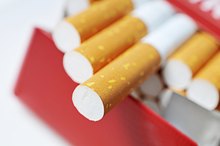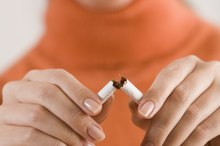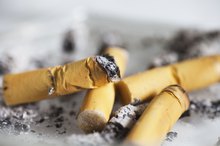What Are the Timeline Benefits of Not Smoking?
The benefits of quitting smoking include huge financial, social and cosmetic gains 1. However, the most important benefit is to enable the body to regain good health, and the process begins almost immediately after you extinguish the final cigarette. A smoker will experience many rewarding gains during the first few weeks after quitting; many others may go unnoticed, but are vital components for the possibility of a long, healthy life.
If you are experiencing serious medical symptoms, seek emergency treatment immediately.
First Day
Twenty minutes after you put out the last cigarette, your pulse rate and blood pressure will return to normal. After eight hours, the remaining nicotine in your bloodstream will be only 6.25 percent of your normal peak levels. After 12 hours have passed, your blood oxygen and carbon monoxide levels will have returned to normal. At around 24 hours after the last cigarette, you will feel probably experience high anxiety levels, but after the first day has passed this will begin to improve.
- Twenty minutes after you put out the last cigarette, your pulse rate and blood pressure will return to normal.
- After eight hours, the remaining nicotine in your bloodstream will be only 6.25 percent of your normal peak levels.
First Week
What Happens After 15 Days of Not Smoking?
Learn More
Around the 48-hour mark, you will find your senses of smell and taste begin to return. It is also around this time your irritability and feelings of anger will be at their worst--by the third day, these emotions should subside a little. Smoking causes much damage to nerve endings, but by day three they will start to regrow.
After the end of the third day, you should feel less irritable and angry. You may notice a small increase in appetite, and you will be able to breathe more easily. You should also experience an increase in energy. Your body is now 100 percent free from nicotine, and any cravings you experience from now will be triggered by habit rather than physical withdrawal. Towards the end of the first week, you will probably still experience around three craving episodes per day. Timing these cravings can help them to evaporate very quickly.
After five days, you should notice a definite improvement in the appearance of your skin. It will have lost its unattractive gray pallor, and be replaced by a healthier tone as circulation begins to improve.
- Around the 48-hour mark, you will find your senses of smell and taste begin to return.
- You may notice a small increase in appetite, and you will be able to breathe more easily.
First Fortnight
After 10 days, you will encounter, on average, only two short craving periods a day. Blood circulation is returning to normal, and is similar to that of a non-smoker. Your lung function will have also increased.
First Month
Effects to the Body 20 Minutes After Smoking a Cigarette
Learn More
During the first month, your lung function will continue to improve. Your feelings of irritability, anxiety and anger should have cleared completely, and you will be rejoicing in your decision to quit.
Your brain acetylcholine receptor counts become up-regulated when nicotine is present. Toward the end of the first month, they will have down-regulated sufficiently to be on par with levels of the brains of non-smokers.
- During the first month, your lung function will continue to improve.
- Toward the end of the first month, they will have down-regulated sufficiently to be on par with levels of the brains of non-smokers.
First Six Months
During the first six months, your risk of having a heart attack has already started to drop. Your lung function continues to increase, and you should find exercise and walking easier. If you had a smoker's cough, it is now likely to have disappeared.
First Year
During the first year, any sinus congestion that was related to smoking will have diminished or be clear. The tiny hair-like structures known as cilia will have regrown, increasing the lung's capabilities of handling mucus. You will have increased energy.
First Two Years and Beyond
After the first year, your risk of having a heart attack is less than half compared to a smoker. After five years, your stroke risk is equal to that of a non-smoker. After 10 years, the average smoker's risk of lung cancer is half that of a smoker. After 13 years, your risk of experiencing tooth loss due to smoking is non-existent. After 15 years, your risk of heart disease is equal to that of a non-smoker. After 20 years, any risk of becoming ill due to smoking is negligible.
- After the first year, your risk of having a heart attack is less than half compared to a smoker.
- After 15 years, your risk of heart disease is equal to that of a non-smoker.
Related Articles
References
- Cancer: Guide to Quitting Smoking Benefits
- National Health Service: Health Benefits of Stopping Smoking
- Why Quit: Benefits Time Table
- "Allen Carr's Easy Way to Stop Smoking"; Allen Carr; 2006
- Gometz ED. Health effects of smoking and the benefits of quitting. Virtual Mentor. 2011;13(1):31-5. doi:10.1001/virtualmentor.2011.13.1.cprl1-1101
- American Cancer Society. Benefits of quitting smoking over time. Updated November 1, 2018.
- Da Ré AF, Gurgel LG, Buffon G, Moura WER, Marques Vidor DCG, Maahs MAP. Tobacco influence on taste and smell: Systematic review of the literature. Int Arch Otorhinolaryngol. 2018;22(1):81-87. doi:10.1055/s-0036-1597921
- Willemse BW, Postma DS, Timens W, Ten Hacken NH. The impact of smoking cessation on respiratory symptoms, lung function, airway hyperresponsiveness and inflammation. Eur Respir J. 2004;23(3):464-76. doi:10.1183/09031936.04.00012704
- Cho YH, Jeong DW, Seo SH, et al. Changes in skin color after smoking cessation. Korean J Fam Med. 2012;33(2):105-9. doi:10.4082/kjfm.2012.33.2.105
- Sarokhani M, Veisani Y, Mohamadi A et al. Association between cigarette smoking behavior and infertility in women: A case-control study. Biomed Res Ther. 2017;4(10):1705-1715. doi:10.15419/bmrat.v4i10.376
- Practice Committee of the American Society for Reproductive Medicine. Smoking and infertility: A committee opinion. Fertil Steril. 2012;98(6):1400-6. doi:10.1016/j.fertnstert.2012.07.1146
- Wu J, Sin DD. Improved patient outcome with smoking cessation: When is it too tate?. Int J Chron Obstruct Pulmon Dis. 2011;6:259-67. doi:10.2147/copd.s10771
Writer Bio
Deborah Green has been providing online content in the health and fitness industries since 2001. She holds a Bachelor of Arts in English language teaching from Sussex University and is pursuing a Bachelor of Arts/Bachelor of Science in health studies from The Open University.









